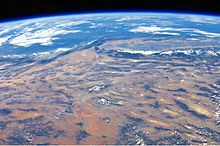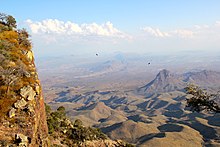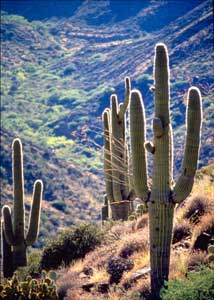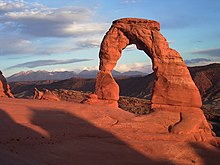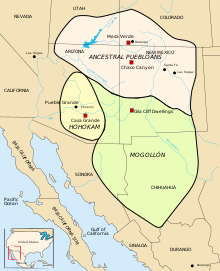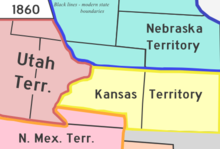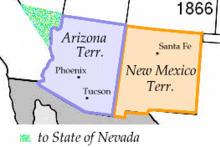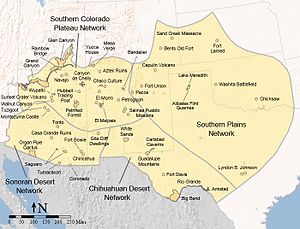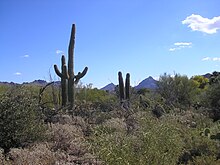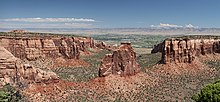Southwestern United States
| |
|---|---|
| American Southwest, the Southwest | |
|
Left – right from top: Downtown Phoenix, AZ; Monument Valley; Cathedral Rock - Sedona, AZ; Arches National Park; Hoover Dam; Mojave Desert willow; Caesars Palace on the Las Vegas Strip, NV.
| |
![Though regional definitions vary from source to source, Arizona and New Mexico (in dark red) are almost always considered the core, modern-day Southwest. The brighter red and striped states may or may not be considered part of this region. The brighter red states (California, Colorado, Nevada, and Utah) are also classified as part of the West by the U.S. Census Bureau, though the striped states are not (Oklahoma and Texas).[1]](https://upload.wikimedia.org/wikipedia/commons/thumb/e/ef/Southwest_map.png/250px-Southwest_map.png)
Though regional definitions vary from source to source, Arizona and New Mexico
(in dark red) are almost always considered the core, modern-day
Southwest. The brighter red and striped states may or may not be
considered part of this region. The brighter red states (California, Colorado, Nevada, and Utah) are also classified as part of the West by the U.S. Census Bureau, though the striped states are not (Oklahoma and Texas).
| |
| Coordinates: 37°N 111°WCoordinates: 37°N 111°W | |
| Country | United States |
| States | Core: Arizona New Mexico Others, depending on boundaries used: California Colorado Nevada Utah Oklahoma (mainly western) Texas (mainly western) |
The Southwestern United States, also known as the American Southwest, Desert Southwest, or simply the Southwest, is the informal name for a region of the western United States. Definitions of the region's boundaries vary a great deal and have never been standardized, though many boundaries have been proposed. For example, one definition includes the stretch from the Mojave Desert in California (117° west longitude) to Carlsbad, New Mexico (104° west longitude), and from the Mexico–United States border to the southern areas of Colorado, Utah, and Nevada (39° north latitude). The largest metropolitan areas are centered around Phoenix (with an estimated population of more than 4.7 million as of 2017), Las Vegas (more than 2.2 million), Tucson (more than 1 million), Albuquerque (more than 900,000), and El Paso (more than 840,000). Those five metropolitan areas have an estimated total population of more than 9.6 million as of 2017, with nearly 60 percent of them living in the two Arizona cities—Phoenix and Tucson.
Most of the area was part of the Viceroyalty of New Spain in the Spanish Empire before becoming part of Mexico. European settlement was almost non-existent outside New Mexico in 1848, when it became part of the United States through the Treaty of Guadalupe Hidalgo, while southern areas of Arizona and southwestern New Mexico were added in the later Gadsden Purchase.
Regional geography
Panoramic view of the southwestern United States
The geography of the region is mainly made up by four features: the Mojave, Sonoran, and Chihuahuan Deserts, and the Colorado Plateau; although there are other geographical features as well, such as a portion of the Great Basin Desert.
The deserts dominate the southern and western reaches of the area,
while the plateau (which is largely made up of high desert) is the main
feature north of the Mogollon Rim. The two major rivers of the region are the Colorado River, running in the northern and western areas, and the Rio Grande, running in the east, north to south.
The Chihuahuan desert terrain mainly consists of basins broken by numerous small mountain ranges.
Formed approximately 8000 years ago, the Chihuahuan Desert is a relatively dry desert, although it is slightly wetter than the Sonoran Desert to the west.
The Chihuahuan Desert spreads across the southeastern portion of the
region, covering from southeastern Arizona, across southern New Mexico,
and the portion of Texas included in the Southwest. While it is the second largest desert in the United States, only a third of the desert is within the United States, with the rest in Mexico. El Paso and Albuquerque are the major US cities in this desert, with other smaller cities being Las Cruces and Roswell in New Mexico and Willcox in Arizona.
The elevation in the Chihuahuan varies from about 1,750 to 6,000 feet, as there are several larger mountain ranges, such as the Organ Mountains, the Guadalupe Mountains, and the Chiracahua Mountains, plus many smaller mountain ranges contained in the area, namely the San Andres and Doña Anas in New Mexico, the Franklin Mountains and the Davis Mountains.
The Chihuahuan is a "rain shadow" desert, formed between two mountain
ranges (the Sierra Madre Occidental on the west and the Sierra Madre
Oriental on the east) which block oceanic precipitation from reaching
the area.
The Chihuahuan Desert is considered the "most biologically diverse
desert in the Western Hemisphere and one of the most diverse in the
world", and includes more species of cacti than any other desert in the
world. The most prolific plants in this region are agave, yucca and creosote bushes, in addition to the ubiquitous presence of various cacti species.
Saguaro cactus in the Sonoran Desert.
When people think of the desert southwest, the landscape of the Sonoran Desert is what mostly comes to mind.
The Sonoran Desert makes up the southwestern portion of the Southwest;
most of the desert lies in Mexico, but its United States component lies
on the southeastern border of California, and the western 2/3 of
southern Arizona. Rainfall averages between 4–12 inches per year, and
the desert's most widely known inhabitant is the saguaro cactus, which is unique to the desert. It is bounded on the northwest by the Mojave Desert, to the north by the Colorado Plateau and to the east by the Arizona Mountains forests and the Chihuahuan Desert. Aside from the trademark saguaro, the desert has the most diverse plant life of any desert in the world,
and includes many other species of cacti, including the organ-pipe,
senita, prickly pear, barrel, fishhook, hedgehog, cholla, silver dollar,
and jojoba.
The portion of the Sonora Desert which lies in the Southwestern United
States is the most populated area within the region. Six of the top ten
major population centers of the region are found within its borders:
Phoenix, Tucson, Mesa, Chandler, Glendale, and Scottsdale, all in
Arizona. Also within its borders are Yuma and Prescott Arizona.
The most northwest portion of the American Southwest is covered
by the Mojave Desert. Bordered on the south by the Sonoran Desert and
the east by the Colorado Plateau, its range within the region makes up
the southeast tip of Nevada, and the northwestern corner of Arizona. In terms of topography, the Mojave is very similar to the Great Basin Desert, which lies just to its north.
Within the region, Las Vegas is the most populous city; other
significant areas of human habitation include Laughlin and Pahrump in
Nevada, and Lake Havasu City, Kingman, and Bullhead City in Arizona. The
Mojave is the smallest, driest and hottest desert within the United
States. The Mojave gets less than six inches of rain annually, and its elevation ranges from 3000 to 6000 feet above sea level. The most prolific vegetation is the tall Joshua tree, which grow as tall as 40 feet, and are thought to live almost 1000 years.
Other major vegetation includes the Parry saltbush and the Mojave sage,
both only found in the Mojave, as well as the creosote bush.
The Delicate Arch at Arches National Park
The Colorado Plateau varies from the large stands of forests in the west, including the largest stand of ponderosa pine trees in the world, to the Mesas to the east.
Although not called a desert, the Colorado Plateau is mostly made up of
high desert. Within the Southwest U.S. region, the Colorado is bordered
to the south by the Mogollon Rim and the Sonoran Desert, to the west by
the Mojave Desert, and to the east by the Rocky Mountains and the Llano Estacado. The Plateau is characterized by a series of plateaus and mesas, interspersed with canyons. The most dramatic example is the Grand Canyon.
But that is one of many dramatic vistas included within the Plateau,
which includes spectacular lava formations, "painted" deserts, sand
dunes, and badlands.
One of the most distinctive features of the Plateau is its longevity,
having come into existence at least 500 million years ago.
The Plateau can be divided into six sections, three of which fall into
the Southwest region. Beginning with the Navajo section forming the
northern boundary of the Southwestern United States, which has shallower
canyons than those in the Canyonlands section just to its north; the
Navajo section is bordered to the south by the Grand Canyon section,
which of course is dominated by the Grand Canyon; and the
southeastern-most portion of the Plateau is the Datil section,
consisting of valleys, mesas, and volcanic formations.
Albuquerque is the most populous city often considered at the edge of
this portion contained in the Southwest region, but Santa Fe, New Mexico
and Flagstaff, Arizona, are also significant population centers.
Geographer D. W. Meinig defines the Southwest in a very similar fashion to Reed: the portion of New Mexico west of the Llano Estacado and the portion of Arizona east of the Mojave-Sonoran Desert and south of the "canyon lands" and also including the El Paso district of western Texas and the southernmost part of Colorado. Meinig breaks the Southwest down into four distinct subregions. He calls the first subregion "Northern New Mexico", and describes it as focused on Albuquerque and Santa Fe. It extends from the San Luis Valley of southern Colorado to south of Socorro and including the Manzano Mountains, with an east-west breadth in the north stretching from the upper Canadian River to the upper San Juan River. The area around Albuquerque is sometimes called Central New Mexico.
"Central Arizona" is a vast metropolitan area spread across one contiguous sprawling oasis, essentially equivalent to the Phoenix metropolitan area. The city of Phoenix is the largest urban center, and located in the approximate center of the area that includes Tempe, Mesa, and many others.
Meinig calls the third subregion "El Paso, Tucson, and the Southern Borderlands". While El Paso and Tucson are distinctly different cities, they serve as anchor points to the hinterland between them. Tucson
occupies a large oasis at the western end of the El Paso-Tucson
corridor. The region between the two cities is a major transportation
trunk with settlements servicing both highway and railway needs. There
are also large mining operations, ranches, and agricultural oases. Both
El Paso and Tucson have large military installations nearby; Fort Bliss and White Sands Missile Range north of El Paso in New Mexico, and, near Tucson, the Davis-Monthan Air Force Base. About 70 miles (110 km) to the southeast are the research facilities at Fort Huachuca.
These military installations form a kind of hinterland around the El
Paso-Tucson region, and are served by scientific and residential
communities such as Sierra Vista, Las Cruces, and Alamogordo. El Paso's influence extends north into the Mesilla Valley, and southeast along the Rio Grande into the Trans-Pecos region of Texas.
The fourth subregion Meinig calls the "Northern Corridor and
Navajolands". A major highway and railway trunk which connects
Albuquerque and Flagstaff. Just north of the transportation trunk are large blocks of American Indian land.
Phoenix, Tucson, and Las Vegas dominate the westernmost metropolitan areas in the Southwest, while Albuquerque, and El Paso dominate the easternmost metropolitan areas.
History
Pre-European contact
Ancestral Puebloans ruins at Chaco Canyon
Human history in the Southwest begins with the arrival of the Clovis culture, a Paleo-Indian hunter-gatherer culture which arrived sometime around 9000 BC. This culture remained in the area for several millennia. At some point they were replaced by three great Pre-Columbian Indian cultures: the Ancestral Pueblo people, the Hohokam, and the Mogollon, all of which existed among other surrounding cultures including the Fremont and Patayan.
Maize began to be cultivated in the region sometime during the early
first millennium BC, but it took several hundred years for the native
cultures to be dependent on it as a food source. As their dependence on maize grew, Pre-Columbian Indians began developing irrigation systems around 1500.
Map of Paleo-Indians in the American Southwest and Mexico
According to archeological finds, the Ancestral Pueblo people, also
known as the Anasazi (although that term is becoming more and more
disused), began settling in the area in approximately 1500 BC. Eventually, they would spread throughout the entire northern section of the Southwest.
This culture would go through several different eras lasting from
approximately 1500 BC through the middle of the 15th century AD: the Basketmaker I, II, and III phases followed by the Pueblo I, II, III, and IV. As the Puebloans transitioned from a nomadic lifestyle to one based on agriculture, their first domiciles were pithouses. The Mogollon culture developed later than the Puebloan, arising in the eastern area of the region at around 300 BC. Their range would eventually extend deep into what would become Mexico, and dominate the southeastern portion of the Southwest.
Their settlements would evolve over time from pit-dwellings through
pueblos and finally also incorporating cliff-dwellings. The Hohokam
were the last of these ancestral cultures to develop, somewhere around
AD 1, but they would grow to be the most populous of the three by AD
1300, despite being the smallest of the three in terms of area, covering
most of the southwest portion. Beginning in approximately AD 600, the Hohokam began to develop an extensive series of irrigation canals; of the three major cultures in the Southwest, only the Hohokam developed irrigation as a means of watering their agriculture.
Not long after the Hohokam reached the height of their culture,
all three major cultures in the Southwest began to decline, for unknown
reasons, although severe drought and encroachment from other peoples has
been postulated. By the end of the 15th century, all three cultures had
disappeared. The modern Indian tribes of the Hopi, Zuni, Acoma, and Laguna trace their ancestry back to the ancestral Puebloans, while the Akimel O'odham and Tohono O'odham claim descent from Hohokam. The area previously occupied by the Mogollon was taken over by an unrelated tribe, the Apache.
While it is unclear whether any of the modern Indian tribes are
descended from the Mogollon, some archeologists and historians believe
that they mixed with Ancestral Puebloans and became part of the Hopi and
Zuni.
Oraibi pueblo
Prior to the arrival of Europeans, the Southwestern United States was inhabited by a very large population of American Indian
tribes. The area once occupied by the ancestral Puebloans became
inhabited by several American Indian tribes, the most populous of which
were the Navajo, Ute, Southern Paiute,
and Hopi. The Navajo, along with the Hopi, were the earliest of the
modern Indian tribes to develop in the Southwest. Around AD 1100 their
culture began to develop in the Four Corners area of the region. The Ute were found over most of modern-day Utah and Colorado, as well as northern New Mexico and Arizona.
The Paiutes roamed an area which covered over 45,000 square miles of
southern Nevada and California, south-central Utah, and northern
Arizona. The Hopi settled the lands of the central and western portions of northern Arizona. Their village of Oraibi, settled in approximately AD 1100, is one of the oldest continuously occupied settlements in the United States.
The Mogollon area became occupied by the Apaches and the Zuni. The
Apache migrated into the American Southwest from the northern areas of
North America at some point between 1200 and 1500. They settled throughout New Mexico, eastern Arizona, northern Mexico, parts of western Texas, and southern Colorado. The Zuni count their direct ancestry through the ancestral Puebloans. The modern day Zuni established a culture along the Zuni River in far-eastern Arizona and western New Mexico.
Both major tribes of the O'odham tribe settled in the southern and
central Arizona, in the lands once controlled by their ancestors, the
Hohokam.
Arrival of Europeans
Narváez expedition (1528–36)
The first European intrusion into the region came from the south. In 1539, a Jesuit Franciscan named Marcos de Niza led an expedition from Mexico City which passed through eastern Arizona. The following year Francisco Vázquez de Coronado, based on reports from survivors of the Narváez expedition
(1528–36) who had crossed eastern Texas on their way to Mexico City,
led an expedition to discover the Seven Golden Cities of Cíbola. The 1582-3 expedition of Antonio de Espejo explored New Mexico and eastern Arizona; and this led to Juan de Oñate's establishment of the Spanish province of Santa Fe de Nuevo México in 1598, with a capital founded near Ohkay Oweenge Pueblo, which he called San Juan de los Caballeros. Oñate's party also attempted to establish a settlement in Arizona in 1599, but were turned back by inclement weather. In 1610, Santa Fe was founded, making it the oldest capital in United States.
In 1664 Juan Archuleta led an expedition into what is now
Colorado, becoming the first European to enter. A second Spanish
expedition was led into Colorado by Juan Ulibarrí in 1706, during which he claimed the Colorado territory for Spain.
From 1687 to 1691 the Jesuit priest, Eusebio Kino established several missions in the Santa Cruz River valley; and Kino further explored southern and central Arizona in 1694, during which he discovered the ruins of Casa Grande.
Beginning in 1732, Spanish settlers began to enter the region, and the
Spanish started bestowing land grants in Mexico and the Southwest US.
In 1751, the O'odham rebelled against the Spanish incursions, but the
revolt was unsuccessful. In fact, it had the exact opposite effect, for
the result of the rebellion was the establishment of the presidio at Tubac, the first permanent European settlement in Arizona.
In 1768, the Spanish created the Provincia de las Californias,
which included California and the Southwest US. Over approximately the
next 50 years, the Spanish continued to explore the Southwest, and in
1776 the City of Tucson was founded when the Presidio San Augustin del Tucson was created, relocating the presidio from Tubac.
In 1776, two Franciscan priests, Francisco Atanasio Domínguez and Silvestre Vélez de Escalante, led an expedition
from Santa Fe heading to California. After passing through Colorado,
they became the first Europeans to travel into what is now Utah. Their
journey was halted by bad weather in October, and they turned back,
heading south into Arizona before turning east back to Santa Fe.
1846 map: Mexican Alta California (Upper California) in pink.
In 1804 Spain divided the Provincia de las Californias, creating the province Alta California,
which consisted primarily of what would become California, Nevada,
Arizona, Colorado, Utah and New Mexico. In 1821 Mexico achieved its
independence from Spain and shortly after, in 1824, developed its constitution, which established the Alta California territory, which was the same geographic area as the earlier Spanish province.
In 1825, Arizona was visited by its first non-Spanish Europeans, English trappers. In 1836, the Republic of Texas,
which contained the easternmost of the Southwest United States, won its
independence from Mexico. In 1845 the Republic of Texas was annexed by
the United States, and immediately became a state, bypassing the usual
territory phase. The new state still contained portions of what would
eventually become parts of other states. In 1846, the Southwest became embroiled in the Mexican–American War,
partly as a result of the United States' annexation of Texas. On August
18, 1846, an American force captured Santa Fe, New Mexico.
On December 16 of the same year, American forces captured Tucson,
Arizona, marking the end of hostilities in the Southwest United States. When the war ended with the Treaty of Guadalupe Hidalgo
on February 2, 1848, the United States gained control of all of
present-day California, Nevada and Utah, as well as the majority of
Arizona, and parts of New Mexico and Colorado (the rest of present-day
Colorado, and most of New Mexico had been gained by the United States in
their annexation of the Republic of Texas).
The final portion of the Southwestern United States came about through
the acquisition of the southernmost parts of Arizona and New Mexico
through the Gadsden Purchase in 1853.
In 1851, San Luis became the first European settlement in what is now Colorado.
Becoming states
United States 1849–1850
United States 1850–1853
Of the states of which at least a portion make up the Southwest,
Texas was the first to achieve statehood. On December 29, 1845 the
Republic of Texas was annexed, bypassing the status of becoming a
territory, and immediately became a state.
Initially, its borders included parts of what would become several
other states: almost half of New Mexico, a third of Colorado, and small
portions of Kansas, Oklahoma, and Wyoming. Texas current borders were set in the Compromise of 1850,
where Texas ceded land to the federal government in exchange for $10
million, which would go to paying off the debt Texas had accumulated in
its war with Mexico.
Following the Mexican Cession, the lands of what had been the
Mexican territory of Alta California were in flux: portions of what is
now New Mexico were claimed, but never controlled, by Texas. With the
Compromise of 1850, the states of Texas and California were created
(Texas as a slave state, and California as a free state), as well as the
Utah Territory and New Mexico Territory.
The New Mexico Territory consisted of most of Arizona and New Mexico
(excluding a strip along their southern borders), a small section of
southern Colorado, and the very southern tip of Nevada; while the Utah Territory consisted of Utah, most of Nevada, and portions of Wyoming and Colorado.
The New Mexico Territory was expanded along its southern extent, to its
current border, with the signing of the Gadsden Purchase Treaty on
December 30, 1853, which was ratified by the U.S. Congress, with some slight alterations, in April 1854.
1860 Colorado Territory map
Utah Territory evolution 1850–1868
The Colorado Territory
was organized on February 28, 1861, created out of lands then currently
in the Utah, Kansas, Nebraska, and New Mexico territories. The Nevada Territory
was also organized in 1861, on March 2, with land taken from the
existing Utah Territory. Initially, only the western 2/3 of what is
currently the State of Nevada was included in the territory, with its
boundary to the east being the 116th meridian, and to the south the 37th parallel. In 1862 Nevada's eastern border shifted to the 115th meridian, and finally to its current position at the 114th meridian
in 1866. The boundary modification in 1866 also included adding the
southern triangular tip of the present-day state, taken from the Arizona
Territory.
From July 24–27, 1861 a Confederate force under the command of
Lt. Colonel John Robert Baylor forced the surrender of the small Union
garrison stationed at Fort Fillmore, near Mesilla, New Mexico.
On August 1, 1861, Baylor declared the creation of the Arizona
Territory, and claimed it for the confederacy, with Mesilla as its
capital.
The territory, which had been formed by the portion of the existing New
Mexico Territory below the 34th parallel, became official on February
14, 1862.
Confederate Arizona (outlined in blue)
Split of Arizona and New Mexico territories, in 1866, after small portion ceded to Nevada
Nevada was admitted to the Union on October 31, 1864, becoming the 36th state. This was followed by the admittance to the Union of Colorado, which became the 38th state on August 1, 1876.
Confederate Arizona was short-lived, however. By May 1862 confederate
forces had been driven out of the region by union troops. That same
month a bill was introduced into the U.S. Congress, and in February 24,
1863 Abraham Lincoln signed the Arizona Organic Act, which officially created the U.S. Territory of Arizona, splitting the New Mexico Territory at the 107th meridian.
Utah, as shown above, evolved out of the Utah Territory, as
pieces of the original territory created in 1850 were carved out: parts
were ceded to Nevada, Wyoming, and Colorado in 1861; another section to
Nevada in 1862; and the final section to Nevada in 1866. In 1890, the LDS church issued the 1890 Manifesto, which officially banned polygamy for members of the church.
It was the last roadblock for Utah entering the Union, and on January
4, 1896 Utah was officially granted statehood, becoming the 45th state.
In 1869, John Wesley Powell led a 3-month expedition which explored the Grand Canyon and the Colorado River. In 1875, he would publish a book describing his explorations, Report of the Exploration of the Columbia River of the West and Its Tributaries, which was later republished as The Exploration of the Colorado River and Its Canyons.
In 1877 silver was discovered in southeastern Arizona. The notorious mining town of Tombstone, Arizona was born to service the miners.
The town would become immortalized as the scene of what is considered
the greatest gunfight in the history of the Old West, the Gunfight at the O.K. Corral.
Copper was also discovered in 1877, near Bisbee and Jerome
in Arizona, which became an important component of the economy of the
Southwest. Production began in 1880, and was made more profitable by the
expansion of the railroad throughout the territory during the 1880s.
The second transcontinental railroad: the "Santa Fe Route" – 1891.
The early 1880s also saw the completion of the second
transcontinental railroad, which ran through the heart of the Southwest,
called the "Sante Fe Route". It ran from Chicago, down through Topeka,
then further south to Albuquerque, before heading almost due west
through northern Arizona to Los Angeles.
The repeal of the Sherman Silver Purchase Act in 1893 led to the decline of the silver mining industry in the region.
In 1901, the Santa Fe Railroad reached the South Rim of the Grand Canyon, opening the way for a tourism boom, a trend led by restaurant and hotel entrepreneur Fred Harvey.
The last two territories within the Southwest to achieve
statehood were New Mexico and Arizona. By 1863, with the splitting off
of the Arizona Territory, New Mexico reached its modern borders. They
became states within forty days of one another. On January 6, 1912, New
Mexico became the 47th state in the Union. Arizona would shortly follow, becoming the last of the 48 contiguous United States on February 14, 1912.
From statehood through World War II
The 1930s saw the beginning of the ski industry in Colorado. Resorts were established in areas such as Estes Park, Gunnison, and on Loveland Pass. At the end of the decade, in 1939, with the establishment of Alta Ski Area, Utah's skiing began to be developed.
Due to the ski conditions in the state, during WWII, the 10th Mountain Division established Camp Hale in Colorado to train elite ski troops.
The post-war years through the end of the millennium
In 1967, Governor John A. Love signed the nation's first liberalized abortion law.
In 1999, the Columbine High School massacre
became the most devastating high-school massacre in United States
history, when two students killed 12 of their classmates and one teacher
before taking their own lives.
21st century
On July 20, 2012, Colorado became the scene of one of the largest mass shootings in U.S. history, the Aurora shooting, which resulted in the deaths of 12 people, with another 70 injured. Also in 2012, Colorado voters passed a law legalizing the recreational use of marijuana.
Origins of the term and historical/cultural variations
While
this article deals with the core definition for the American Southwest,
there are many others. The various definitions can be broken down into
four main categories: Historical/Archeological;
Geological/Topographical; Ecological; and Cultural. In the 1930s and
1940s, many definitions of the Southwest included all or part of Texas,
Oklahoma, New Mexico, Arizona, California, Colorado, and Utah. As time
has gone on, the definition of the Southwest as become more solidified
and more compact. For example, in 1948 the National Geographic Society
defined the American Southwest as all of California, Nevada, Utah,
Arizona, Colorado, and New Mexico, and the southernmost sections of
Oregon, Idaho, and Wyoming, as well as parts of southwest Nebraska,
western Kansas, Oklahoma, and Texas. By 1977, the Society's definition
had narrowed to only the four states of Utah, Arizona, Colorado, and New
Mexico; and by 1982 the portion of the Southwest in the United States,
as defined by the Society, had shrunk to Arizona and New Mexico, with
the southernmost strip of Utah and Colorado, as well as the Mojave and
Colorado deserts in California.
Other individuals who focus on Southwest studies who favored a more
limited extent of the area to center on Arizona and New Mexico, with
small parts of surrounding areas, include Erna Fergusson, Charles Lummis (who claimed to have coined the term, the Southwest), and cultural geographer Raymond Gastil, and ethnologist Miguel León-Portilla.
Historical/archeological
As the US expanded westward, the country's western border also shifted westward, and consequently, so did the location of the Southwestern and Northwestern United States. In the early years of the United States, newly colonized lands lying immediately west of the Appalachian Mountains were detached from North Carolina and given the name Southwest Territory. During the decades that followed, the region known as "the Southwestern United States" covered much of the Deep South east of the Mississippi River.
However, as territories and eventual states to the west were added after the Mexican–American War,
the geographical "Southwest" expanded, and the relationship of these
new acquisitions to the South itself became "increasingly unclear."
However, archeologist, Erik Reed, gives a description which is
the most widely accepted as defining the American Southwest, which runs
from Durango, Colorado in the north, to Durango, Mexico, in the south,
and from Las Vegas, Nevada in the west to Las Vegas, New Mexico in the
East. Reed's definition is roughly equivalent to the western half of the
Learning Center of the American Southwest's definition, leaving out any
portion of Kansas and Oklahoma, and much of Texas, as well as the
eastern half of New Mexico. Since this article is about the Southwestern
United States, the areas of Sonora and Chihuahua in Mexico will be
excluded. The portion left includes Arizona and western New Mexico, the
very southernmost part of Utah, southwestern Colorado, the very tip of
west Texas, and triangle formed by the southern tip of Nevada. This will
be the defined scope which is used in this article, unless otherwise
specified in a particular area.
Geological/topographical
From
this perspective, almost all of the region's physiographical traits,
geological formations, and weather are contained within a box between
26° and 38° northern latitude, and 98° 30' and 124° western longitude.
Ecological
When
looking at the fauna of the region, there is a broader definition of
the American Southwest. The Southwestern Center for Herpetological
Research defines the Southwest as being only the states of Arizona, New
Mexico, with parts of California, Nevada, Texas, and Utah; although they
include all of those six states in their map of the region, solely for
ease of defining the border.
Cultural
Map of the Southwestern United States as defined by the Learning Center of the American Southwest
Parts of the other states make up the various areas which can be
included in the Southwest, depending on the source. The Learning Center
of the American Southwest (LCAS)
does not rely on current state boundaries, and defines the American
Southwest as parts of Arizona, Colorado, Kansas, New Mexico, Oklahoma,
Texas, and Utah.
Lawrence Clark Powell, a major bibliographer whose emphasis is on the Southwest, defined the American Southwest in a 1958 Arizona Highways
article as, "the lands lying west of the Pecos, north of the [Mexican]
Border, south of the Mesa Verde and the Grand Canyon, and east of the
mountains which wall off Southern California and make it a land in
itself.
Texas has long been the focal point of this dichotomy, and is often considered, as such, the core area of "the South's Southwest." While the Trans-Pecos area is generally acknowledged as part of the desert Southwest, most of Texas and large parts of Oklahoma are often placed into a sub-region of the South,
which some consider southwestern in the general framework of the
original application, meaning the "Western South". This is an area
containing the basic elements of Southern history, culture, politics, religion, and linguistic
and settlement patterns, yet blended with traits of the frontier West.
While this particular Southwest is notably different in many ways from
the classic "Old South" or Southeast,
these features are strong enough to give it a separate southwestern
identity quite different in nature from that of the interior
southwestern states to the west.
One of these distinguishing characteristics in Texas—in addition to being a Confederate state
during the Civil War—is that Indigenous and Spanish American culture
never played a central role in the development of this area in relative
comparison to the others, as the vast majority of settlers were Anglo
and blacks from the South. Although the present day state of Oklahoma was Indian Territory
until the early 20th century, many of these American Indians were from
the southeastern United States and became culturally assimilated early
on. The majority of members of these tribes also allied themselves with
the Confederacy during the Civil War. Combined with that, once the
territory was open for settlement, southeastern pioneers made up a
disproportionate number of these newcomers. All this contributed to the
new state having a character that differed from other parts of the
Southwest with large American Indian populations.
The fact that a majority of residents of Texas and
Oklahoma—unlike those in other "southwestern" states—self-identify as
living in the South and consider themselves southerners rather than the
West and westerners—also lends to treating these two states as a
somewhat distinct and separate entity in terms of regional
classification.
Vegetation and terrain
A Joshua tree (yucca brevifolia)
Vegetation of the southwest generally includes various types of yucca, along with saguaro cactus, barrel cactus, prickly pear cactus, desert spoon, creosote bush, sagebrush, and greasewood.
Although cacti is thought to only grow in Arizona and New Mexico, many
native cacti grow throughout Nevada, Utah, Colorado, and west Texas. Steppe
is also located all over the high plains areas in Colorado, New Mexico,
and Texas. The mountains of the southwestern states have large tracts
of alpine trees.
Landscape features of the core southwestern areas include mountains, canyons, mesas, buttes, high broad basins, plateaus, desert lands, and some plains, characteristic of the Basin and Range Province.
The entire southwestern region features semi-arid to arid terrain. The
far eastern part of southwestern Texas, for example the Texas Hill Country, consists of dry, tall, and rugged rocky hills of limestone and granite. South Texas and the Rio Grande Valley is mostly flat with many places consisting of scrub and bare topsoil, much like the deserts further west.
Wildlife
The region has an extremely diverse bird population, with hundreds of species being found in the American Southwest. In the Chiricahua Mountains alone, in southeastern Arizona, there can be found more than 400 species. Species include Canadian (Branta canadensis) and snow geese, sandhill cranes (Grus canadensis), and the roadrunner, the state bird of New Mexico and most famous bird in the region, is found in all states of the Southwest. Birds of prey include the red-tailed hawk (Buteo jamaicensis), Cooper's hawk (Accipiter cooperii), the osprey (Pandion haliaetus), golden eagles (Aquila chrysaetos), Harris's hawk (Parabuteo unicinctus), American kestrel (Falco sparverius), peregrine falcon (Falco peregrinus), the gray hawk (Buteo plagiatus), the barn owl (Tyto alba), the western screech owl (Megascops kennicottii), the great horned owl (Bubo virginianus), the elf owl (Micrathene whitneyi), and the burrowing owl (Athene cunicularia).
Other bird species include the turkey vulture (Cathartes aura), the black vulture (Coragyps atratus), the northern cardinal (Cardinalis cardinalis), the blue grosbeak (Passerina caerulea), the house finch (Haemorhous mexicanus), the lesser goldfinch (Spinus psaltria), the broad-billed hummingbird (Cynanthus latirostris), the black-chinned hummingbird (Archilochus alexandri), Costa's hummingbird (Calypte costae), Gambel's quail (Callipepla gambelii), the common raven (Corvus corax), the Gila woodpecker (Melanerpes uropygialis), the gilded flicker (Colaptes chrysoides), the cactus wren (Campylorhynchus brunneicapillus), and the rock wren (Salpinctes obsoletus). Four types of doves call the Southwest home: the white-winged dove (Zenaida asiatica), the mourning dove (Zenaida macroura), the common ground dove (Columbina passerina), and the Inca dove (Columbina inca).
Mammal species include the bobcat, coyote, black bear, black-tailed jackrabbit, desert cottontail, desert bighorn sheep, mule deer, white-tailed deer, gray fox, mountain lion, river otter, long-tailed weasel, western spotted skunk, pronghorn, raccoon, and Ord's kangaroo rat, all of which can be found in parts of every southwestern state. Elk are found in parts of Colorado, New Mexico, Utah, and Arizona. White-nosed coati, coati, and collared peccary—or javelina—in the Southwest are normally found in southern areas of Arizona, New Mexico, and Texas near the Mexican border. Jaguars can be found in the bootheel region of Southwestern New Mexico. The Mexican wolf (Canis lupus baileyi) was reintroduced to Arizona and New Mexico in 1998.
A U.S. Fish and Wildlife Service study reported a minimum population of
109 Mexican wolves in southwest New Mexico and southeast Arizona at the
end of 2014.
There is a large contingent of snakes native to the region. Among them include: the rosy boa (Lichanura trivirgata); several sub-species of the glossy snake (Arizona elegans); the Trans-Pecos ratsnake (Bogertophis subocularis); several sub-species of shovel-nosed snakes; several sub-species of kingsnake, including the desert kingsnake (Lampropeltis getula splendida) and the Arizona mountain kingsnake (Lampropeltis pyromelana); the Arizona coral snake (Micruroides euryxanthus); the western diamondback rattlesnake (Crotalus atrox); the Trans-Pecos copperhead (Agkistrodon contortrix pictigaster); the Sonoran sidewinder (Crotalus cerastes cercobombus); the Arizona black rattlesnake (Crotalus oreganus cerberus); the western rattlesnake (Crotalus viridis); the Grand Canyon rattlesnake (Crotalus oreganus abyssus), found only in Arizona; several sub-species of the ridge-nosed rattlesnake (Crotalus willardi), the most recent rattlesnake species to be discovered in the United States, including the New Mexico ridge-nosed rattlesnake (Crotalus willardi obscurus), and the Arizona ridge-nosed rattlesnake, the state reptile of Arizona; and the desert massasauga (Sistrurus catenatus edwardsii).
Other reptiles in the region include lizards and turtles. Lizards
are highly represented in the region, the most distinctive denizen
being the Gila monster, native only to the American Southwest and the state of Sonora in Mexico. Other lizards include: Sonoran collared lizard (Crotaphytus nebrius); several types of geckos, including western banded gecko (Coleonyx variegatus), the common house gecko (Hemidactylus frenatus), and the Mediterranean house gecko (Hemidactylus turcicus), the last two species being non-native to the region but have been introduced; the desert iguana (Dipsosaurus dorsalis); the chuckwalla (Sauromalus ater); the greater earless lizard (Cophosaurus texanus scitulus); several sub-species of horned lizards (Phrynosoma); numerous species of spiny lizards (Sceloporus); Gilbert's skink (Plestiodon gilberti); the western skink (Plestiodon skiltonianus); Trans-Pecos striped whiptail (Aspidoscelis inornata heptagrammus); and the Arizona night lizard (Xantusia arizonae). Turtles are less numerous than their other reptilian counterparts, but several are found in the region, including: the western painted turtle (Chrysemys picta bellii); the Rio Grande cooter (Pseudemys gorzugi); the desert box turtle (Terrapene ornata luteola); the Big Bend slider (Trachemys gaigeae gaigeae); the Sonora mud turtle (Kinosternon sonoriense); and the desert tortoise (Gopherus agassizii).
Amphibians include numerous toads and frogs in the American Southwest. Toads which can be found in the region include: the Great Plains toad (Anaxyrus cognatus); the green toad (Anaxyrus debilis); the Arizona toad (Anaxyrus microscaphus); the New Mexico spadefoot (Spea multiplicata stagnalis); and the Colorado River toad (Incilius alvarius), also known as the Sonoran Desert toad. Frog representation includes: western barking frog (Craugastor augusti); the canyon tree frog (Hyla arenicolor); the Arizona treefrog (Hyla wrightorum); the western chorus frog (Pseudacris triseriata); Chiricahua leopard frog (Lithobates chiricahuensis); and the relict leopard frog (Lithobates onca). There are quite a few salamanders throughout the region, including: the Arizona tiger salamander (Ambystoma mavortium nebulosum) and the painted ensatina (Ensatina eschscholtzii picta).
Climate
Sonoran Desert terrain near Tucson
The southwestern United States features a semi-arid to arid climate, depending on the location.
Much of the Southwest is an arid desert climate, but higher elevations
in the mountains in each state, with the exception of West Texas,
feature alpine climates with very large amounts of snow. The
metropolitan areas of Phoenix, Tucson, Las Vegas, and El Paso hardly
ever receive any snow at all, as they are strictly desert lands with
mountains.
Albuquerque receives less snow than other cities, but still receives
significant snowfalls occasionally in the winter time. Although it snows
in this region, the snow in this part of the United States melts
rapidly, often before nightfall. This is due mainly to the higher
altitude and abundant sunshine in these states.
Nevada and Arizona are both generally arid with desert lands and
mountains, and receive large amounts of snow in the higher elevations in
and near the mountains. New Mexico, Utah, and Colorado are generally
arid, with desert lands and mountains as well. They all receive decent
amounts of snow and large amounts of snow in the high elevations in the
mountains, although some areas in far southwestern and southern New
Mexico do not receive much snow at all at lower elevations. West Texas
is generally arid as well but does not receive the same amount of snow
that the other southwestern states receive at their high elevations. The
terrain of western Texas in the Southwest is the flat, rolling land of
the plains, which eventually turns into a desert with some hills. There
are significant mountains as well in west Texas upon reaching the Trans-Pecos area.
The term "High Desert" is also synonymous with this region. The High Desert is generally defined as the Mojave Desert,
which extends from inland southern California into southern Nevada, and
southwestern Utah. The High Desert also extends into other parts of the
Northwest, such as the Red Desert in southwestern Wyoming. The High Desert is very different from the general desert lands found in Arizona, in the Sonoran Desert.
This area of the desert land generally sits at a very high elevation,
much higher than the normal desert land, and can receive very cold
temperatures at night in the winter (with the exception of California,
southern Nevada and southwestern Utah), sometimes near zero degrees on
very cold nights. The High Desert also receives a decent amount of
snowfall in the winter (with the exception of California, southern
Nevada and southwestern Utah) but melts very quickly.
Monument Canyon, some of the high desert lands found in Colorado
Other areas of the Southwest may also be referred to as the "High Desert" such as the Colorado Plateau.
The desert lands found in Eastern Utah, Northern Arizona, Colorado and
New Mexico are usually referred to as the high desert. Colorado has
scattered desert lands found in southern, southwestern, western, and the
northwestern parts of the state. These scattered desert lands are
located in and around areas such as, the Roan Plateau, Dinosaur National Monument, Colorado National Monument, Royal Gorge, Cortez, Dove Creek, Canyons of the Ancients National Monument, Four Corners Monument, Montrose, Blue Mesa Reservoir, Pueblo, San Luis Valley, Great Sand Dunes and Joshua Tree National Park. Besides the Chihuahuan Desert,
lands in southwestern and southern New Mexico, they also have scattered
desert lands in the northwestern and northern portions of their state,
which is referred to as the high desert.
During El Niño, winters and springs are generally colder and
wetter across southern portions of the region, while the northern
portion stays warmer and drier due to a southern jet stream. Under La
Niña, the opposite happens, meaning the cool and wet weather tends to
stay further north.
National parks, monuments and forests
Grand Canyon from the South Rim
The southwestern United States contains many well-known national parks including Grand Canyon in Arizona, Death Valley in California, Great Sand Dunes in Colorado, Arches in Utah, Big Bend in Texas, Great Basin in Nevada, and White Sands in New Mexico.
White Sands National Park, New Mexico
Arizona parks and monuments include Grand Canyon, Monument Valley (a Navajo Nation park), Petrified Forest, and Saguaro national parks; the national monuments of Agua Fria, Canyon de Chelly, Casa Grande Ruins, Chiricahua, Ironwood Forest, Montezuma Castle, Navajo, Organ Pipe Cactus, Pipe Spring, Sonoran Desert, Sunset Crater, Tonto, Tuzigoot, Vermilion Cliffs, Walnut Canyon, and Wupatki. Other federal areas include the Apache–Sitgreaves National Forests and Tumacacori National Historical Park.
Southern California parks and monuments include Death Valley and Joshua Tree national parks; the national monuments of Castle Mountains, Mojave Trails, Sand to Snow, and San Gabriel Mountains; and Mojave National Preserve.
Colorado parks and monuments include Great Sand Dunes, Black Canyon of the Gunnison, and Mesa Verde national parks; the national monuments of Browns Canyon, Canyons of the Ancients, Colorado, Hovenweep, and Yucca House. Other federal areas include Curecanti National Recreation Area and Bent's Old Fort National Historic Site; as well as the national forests of San Isabel, San Juan, and Uncompahgre.
Little Finland in Gold Butte National Monument, Nevada
Nevada has one national park at Great Basin, and the national monuments of Basin and Range, Gold Butte, and Tule Springs Fossil Beds. Other federal areas include Humboldt-Toiyabe National Forest, Lake Mead National Recreation Area, and Red Rock Canyon National Conservation Area.
New Mexico has two national parks, at Carlsbad Caverns and White Sands. National monuments include Aztec Ruins, Bandelier, El Malpais, El Morro, Gila Cliff Dwellings, Kasha-Katuwe Tent Rocks, Organ Mountains–Desert Peaks, Petroglyph, Rio Grande del Norte, and Salinas Pueblo Missions. Other federal park areas include Chaco Culture National Historical Park, Pecos National Historical Park, Sevilleta National Wildlife Refuge, and the national forests of Apache, Carson, Gila, Lincoln, and Santa Fe.
West Texas has two national parks, at Big Bend and Guadalupe Mountains. Other federal park areas include Chamizal National Memorial and Fort Davis National Historic Site.
Utah national parks include Arches, Bryce Canyon, Canyonlands, Capitol Reef, and Zion. National monuments include Bears Ears, Cedar Breaks, Grand Staircase-Escalante, Hovenweep (also in Colorado), Natural Bridges, and Rainbow Bridge. Other federal areas include Glen Canyon National Recreation Area, Dixie National Forest, and Manti–La Sal National Forest.
Ethnicity
The Southwest is ethnically varied, with significant Anglo American and Hispanic American populations in addition to more regional African American, Asian American, and American Indian populations.
Hispanic Americans (mostly Mexican Americans, with large populations of Spanish Americans) can be found in large numbers in every major city in the Southwest such as El Paso (80%), San Antonio (63%), Los Angeles (48%), Albuquerque (47%), Phoenix (43%), Tucson (41%), Las Vegas (32%), and Mesa (27%).
Very large Hispanic American populations can also be found in the smaller cities such as Eagle Pass (96%), Las Cruces (56%), Yuma (55%), Blythe (53%), Pueblo (48%), Santa Fe (48%), and Glendale (36%). Many small towns throughout the southwestern states also have significantly large Latino populations.
The largest African American populations in the Southwest can be found in Las Vegas (10%), San Antonio (7%), and Phoenix (5%).
The largest Asian American populations in the southwest can be found in California and Texas, with some significant Asian population in Phoenix. The most significant American Indian populations can be found in New Mexico and Arizona.
Cities and urban areas
The
area also contains many of the nation's largest cities and metropolitan
areas, despite relatively low population density in rural areas. Phoenix is the fifth most populous city in the country, and Albuquerque and Las Vegas were some of the fastest-growing cities in the United States. Also, the region as a whole has witnessed some of the highest population growth in the United States, and according to the US Census Bureau, in 2008–2009, Utah was the fastest growing state in America. As of the 2010 Census, Nevada
was the fastest growing state in the United States, with an increase of
35.1% in the last ten years. Additionally, Arizona (24.6%), Utah
(23.8%), Texas (20.6%), and Colorado (16.9%) were all in the top ten
fastest growing states as well.







